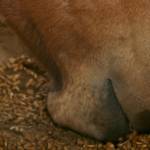Regurgitation in Horses: A Rare Occurrence

As horse owners know, the twisty architecture and delicate microbial population of the equine gastrointestinal tract undermines its resiliency. One other peculiarity enfeebles the tract—a series of one-way passages that prevents horses from regurgitating feed.
Natural-born grazers, horses have gastrointestinal tracts engineered to process forage. A midsize, 1,200-lb (545-kg) adult horse can easily consume 2% of its body weight during a typical grazing day, equivalent to 24 lb (11 kg) of grass clippings.
Always sensitive to changes, the gastrointestinal tract rebels against insult. Horse owners know well the troublesome scenarios—gorging on grain during a nighttime feed-room raid, chomping moldy hay, or plowing through a new bucket of supplement in one fell swoop. Once swallowed, the horse has no other option but to process offending feeds.
Three key physiologic functions keep horses from regurgitating.
- Just prior to swallowing, the horse uses its tongue to push the wad of chewed feed under the soft palate, a structure situated between the mouth cavity and the pharynx. The soft palate funnels the feed through the pharynx and into the esophagus. After ingesta passes through the soft palate, it cannot be driven back into the mouth.
- The esophagus carries the feed wad from the mouth to the stomach by a series of rippling muscle contractions called peristalsis. These contractions cannot, under any circumstances, be shifted into reverse, so the esophagus is categorically a one-way channel.
- The esophagus joins the stomach at a sharp angle, and ingesta must pass through a valve-like structure at the base of the esophagus before it finally reaches the stomach. This structure, like those tissues and junctions preceding it, allows entry but not exit of ingesta.
Some veterinarians and longtime owners have witnessed regurgitation in horses, though usually this is a grave omen, as so much effort must be expended to vomit that stomach rupture occurs concomitantly.








